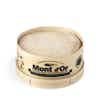





Vacherin Mont d’Or AOC
Rich, Creamy Perfection
TASTING NOTES FROM THE CURATOR
With a fine, almost rosy orange rind, the pâté of the Mont d’Or is creamy—tender and runny—with a mild, almost balsamic taste. It is delicate on the palate, with woodsy flavor notes. Available mostly in the winter months, it is a Christmastime treat. Cheese curds are shaped in a cloth-lined mold to create the initial wheel-like shape, then encased in a strip of bleached spruce to defuse the resin-like residual tastes. The cheese is matured for at least 3 weeks in cool temperatures and lightly brined. The more mature the cheese gets, the creamier and runnier the pâté becomes.
PREPARATION OR PAIRINGS
Because this cheese is runny, it is best to cut it into wedges and serve them in individual small dishes. Add a sprig of rosemary and some crushed garlic to enhance its flavors. A board of salami and pickled vegetables or cornichons with a basket of warm bread on the side will pair perfectly.
Of course, the best way to enjoy the Mont d’Or is by baking it. Preheat an oven to 190ºC, wrap the wooden box in foil with the top exposed, then poke slivers of garlic in through the cheese rind. Pour a quarter cup of dry white wine into the holes and over the cheese, then bake it for up to half an hour. Serve it with more white wine—we like Gewürztraminer, Chardonnay, or Sancerre—or if you prefer beer, a Double or Imperial IPA or an amber Belgian ale will set you to rights.
A TALE OF TWO CHEESES
Well before the creation of delineated borders, in the regions of Haut-Doubs, France and Vaud, Switzerland that included Mont d’Or, monks made this wood-encircled cheese. When the borders were set, a battle for the cheese known as Vacherin Mont d’Or began. The French made theirs from raw cow’s milk and the Swiss turned to a form of pasteurization. The Swiss won the legal rights to the name “Vacherin Mont d’Or” in the 1970s and the French were to call their cheese “Vacherin du Haut-Doubs”. The French being French, of course, place “Vacherin Mont d’Or/Vacherin du Haut-Doubs” on the first line of their official documentation and then proceed to use “Vacherin Mont d’Or”. They even managed to get an AOP from the EU in 1996!
Storage Instructions
Cheeses (except brined ones in jars) should be stored in the crisper or the butter drawer of a refrigerator, not on the shelves themselves. This is to help regulate their temperature and humidity levels—and prevents the formation of mold. Once opened, they should not be kept in their original packaging. Soft cheeses with delicate rinds need to breathe, so they are best placed in glass containers lined with paper towels to absorb extra moisture. Leave the lid open a tiny bit for air to circulate. Cheeses are air-flown from France on demand. They are meant to be consumed within 1 to 2 weeks of their arrival at your residence.










